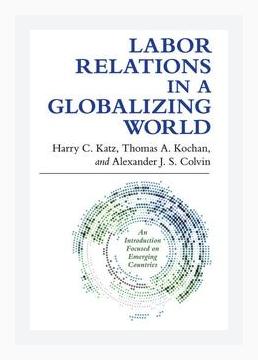Human Resources and Talent ManagementLabor Relations
**
Introduction
“Labor Relations in a Globalizing World” provides an in-depth exploration of how globalization has reshaped labor relations. The authors—Harry C. Katz, Thomas A. Kochan, and Alexander J.S. Colvin—merge theoretical perspectives with practical insights, addressing challenges and strategies relevant to contemporary labor relations. This summary distills key points and actionable advice from the book, structured by major themes.
I. The Impact of Globalization on Labor Relations
A. Market Integration and Competitive Pressures
Globalization has facilitated the integration of markets and intensified competition. Firms face increased pressure to reduce costs, often leading to labor cost containment strategies.
Example: The relocation of manufacturing jobs from developed to developing countries for cheaper labor.
Action: Actively monitor global market trends to anticipate competitive pressures and adapt labor strategies accordingly. For instance, HR managers should conduct regular labor market analyses.
B. Changing Nature of Employment
Employment relationships have shifted from long-term, stable jobs to more precarious and flexible forms of employment, including part-time work, temporary contracts, and gig economy roles.
Example: The rise of platforms like Uber and TaskRabbit, which rely on freelance labor rather than traditional employment contracts.
Action: Develop adaptable employment policies that cater to a diverse workforce. Employers can integrate flexible work options while providing benefits like health insurance to attract and retain talent.
II. Institutional Responses to Globalization
A. Role of Governments
Governments worldwide have responded to globalization in varied ways, from deregulation to protective measures for workers.
Example: European countries like France and Germany have more stringent labor laws compared to more laissez-faire approaches in the United States.
Action: Lobby for balanced labor regulations that protect workers while fostering business growth. HR professionals can engage in policy advocacy for fair labor standards.
B. Labor Unions
Labor unions have struggled but also adapted to the challenges posed by globalization. Union density has generally declined, but unions are also forming transnational alliances and leveraging global campaigns.
Example: The global campaign against Nike for poor labor practices in sweatshops.
Action: Promote or join cross-border union collaborations to enhance collective bargaining power. Labor leaders can network with international union federations to address labor issues globally.
III. Emerging Labor Relations Models
A. High-Performance Work Systems (HPWS)
Some companies have adopted HPWS to improve productivity and worker satisfaction by emphasizing teamwork, skill development, and employee participation in decision-making.
Example: Toyota’s use of “lean manufacturing” and empowering workers through suggestion systems.
Action: Implement HPWS practices by investing in continuous training programs and creating channels for employee feedback and involvement in company decisions.
B. Corporate Social Responsibility (CSR)
Firms increasingly recognize the importance of CSR in maintaining a positive reputation and ensuring sustainable business practices.
Example: Unilever’s Sustainable Living Plan, which aims to double the company’s growth while reducing its environmental footprint.
Action: Integrate CSR initiatives into business strategies. Businesses should develop sustainability goals and regularly report on their progress.
IV. Labor Relations in Different National Contexts
A. United States
The U.S. labor relations system is characterized by a decentralized and adversarial approach, with significant emphasis on individual employment rights over collective bargaining.
Example: The relatively low union density and collective bargaining coverage in the private sector.
Action: Foster a cooperative labor-management relationship. Companies can create joint labor-management committees to address workplace issues collaboratively.
B. Europe
European countries often demonstrate a more collaborative approach with stronger union presence and labor laws supporting collective bargaining and worker participation.
Example: Germany’s co-determination system, where workers have representation on corporate boards.
Action: Advocate for employee representation in corporate governance. Managers can consider implementing works councils or employee advisory boards.
C. Developing Nations
In developing nations, labor relations can be highly varied, often influenced by economic conditions, political stability, and regulatory environments.
Example: Contrasts between burgeoning labor rights movements in countries like China and more volatile labor relations in parts of Africa.
Action: Companies operating in developing countries should engage in ethical labor practices and comply with local labor laws. Ensure that supply chain partners adhere to fair labor standards.
V. Technological Advances Affecting Labor Relations
A. Automation and AI
Technological advancements, particularly automation and AI, are transforming the nature of work, potentially displacing jobs but also creating new opportunities.
Example: Amazon’s use of robotics in warehouses to increase efficiency.
Action: Invest in re-skilling and up-skilling programs for employees. Businesses should assess the impact of technology on jobs and implement training initiatives to prepare workers for new roles.
B. Information and Communication Technologies (ICT)
ICT facilitates new forms of work, such as remote working, and enhances communication within organizations and across borders.
Example: The increased prevalence of telecommuting during the COVID-19 pandemic.
Action: Develop a robust remote work infrastructure. Companies should provide the necessary tools and support for employees to work effectively from various locations.
VI. Strategies for Enhancing Labor-Management Relations
A. Collaborative Bargaining
Promoting a collaborative rather than adversarial bargaining process can lead to more sustainable agreements and improved labor-management relations.
Example: Interest-based bargaining focuses on mutual interests rather than fixed positions.
Action: Train negotiators in collaborative bargaining techniques. Employers and unions can invest in joint training sessions to build trust and understanding.
B. Employee Engagement
Engaging employees through open communication, recognition programs, and involvement in decision-making can lead to higher job satisfaction and performance.
Example: Google’s practice of holding regular town hall meetings where employees can ask questions and receive transparent answers from management.
Action: Implement regular communication forums and recognition programs. Management should encourage open dialogue and acknowledge employee contributions.
Conclusion
“Labor Relations in a Globalizing World” emphasizes the dynamic and complex nature of labor relations in the context of globalization. By addressing market pressures, institutional responses, emerging models, national differences, technological impacts, and strategic enhancements, the book provides a comprehensive framework for navigating contemporary labor challenges. Employing the actionable advice provided can help stakeholders—managers, unions, policymakers, and workers—adapt effectively to the evolving global labor landscape.
